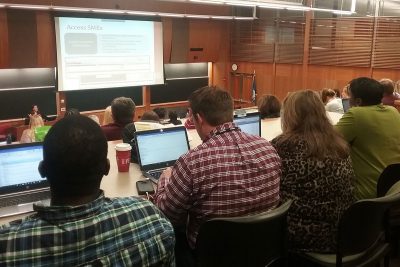
Five months ahead of the debut of UConn Health’s new electronic medical record system, UConn HealthONE, comes a shift in focus to the complicated world of health care reimbursement.
About 60 HealthONE analysts and subject matter experts are leading the effort known as “parallel revenue cycle testing,” which started this week and runs through early March.
“This is a key driver of our ensuring reimbursement,” says UConn Health’s Carolyn Orrell, who’s directing the access and revenue cycle portion of HealthONE. “It’s the next validation of what we built in the system, such as the charges generated from the tests, procedures, and supplies used to provide patient care that will be on the bill/claim sent to various payers.”
This testing phase involves scenarios created in Epic, the software at the heart of HealthONE, designed to measure the effectiveness how the system handles charges, claims, and coding to optimize how UConn Health collects reimbursements.
“This is where we push further and test how scheduling, access, coding, clinical operations, billing and our charge master all integrate with the final goal of getting a claim designed with the right charges and ultimately paid,” says UConn Health Chief Financial Officer Jeff Geoghegan. “This is an important test for the revenue cycle and will determine how well our foundation work has been designed.”
Many of the scripts will be based on services, both inpatient and outpatient, that translate into claims that are considered high frequency, high dollar, complicated, or some combination of those characteristics.
“It will get us to the point that we’ll have confidence that when the claim goes to the payer that we are going to get paid correctly,” Orrell says.
The plan is to run a half dozen scripts each week that represent professional (physician)-based claims and hospital-based claims. Those that don’t pass would be corrected and retested.
“We are shadowing claims that we generate from our current systems to make sure all our Epic processes have the same output, so we can bill correctly and get payment back,” Orrell says. “This will give us opportunities to identify what’s working and what needs to be fixed. It also will help ensure that we won’t be missing out on claims we’re collecting on now.”
The parallel revenue cycle testing will take place on the fourth floor of the Connecticut Tower, a testing area converted from an old John Dempsey Hospital patient floor.
“Success will be when every one of these scenarios is verified to meet our criteria so when claims go out they will look right,” Orrell says. “With minimal delays and accurate data on a claim, we’ll be able to receive payment in a timely fashion.”
This is the last part of the testing phase, which is followed by the training phase on the HealthONE timeline for the April 28, 2018, go-live date.
Watch for additional HealthONE updates in Lifeline, in the Pulse, at uconnhealthexpress.uchc.edu/emr, and now on Twitter @UConnHealthONE.